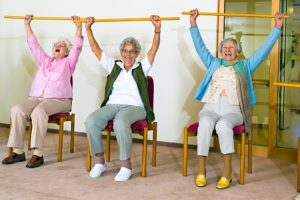
Measurements for pain, pain interference, balance, gait speed, fatigue, and functional ability were taken at baseline, mid-intervention, end of intervention, as well as one and three months post-intervention.
The researchers found that those who took part in the chair yoga showed a greater reduction in pain interference and continued experiencing these benefits for three months. Pain, fatigue, and gait speed were also improved, but those improvements did not last after the intervention was completed. There was no difference in balance measurements between the two groups.
The authors wrote, “Chair yoga should be further explored as a non-pharmacologic intervention for older people with OA [osteoarthritis] in the lower extremities.”
Yoga and arthritis
According to the American College of Rheumatology, physical activity is an important part of treating osteoarthritis and rheumatoid arthritis. Over 75 scientific studies have been published in major medical journals explaining that yoga is a safe and effective form of physical activity and an exercise with great psychological benefits, such as improved mood.
Only recently have the benefits to arthritis patients been made clearer. A handful of yoga and arthritis studies have shown promising results, indicating improvements in joint health, energy level, and mental well-being.
Studies conducted at the University of Pennsylvania have shown that yoga can improve joint stiffness for people with arthritis, while researchers in California have reported improved sleep in arthritis patients who participate in yoga. To date, studies on yoga and arthritis with regards to balance have been mixed, but some early research suggests yoga poses may be able to improve flexibility.
If you are considering yoga exercises to treat symptoms of arthritis, it is best to discuss it with your doctor first. In the meantime, here is a run-down of some of the yoga poses that medical researchers and yoga therapists believe are best for people with arthritis.
Mountain pose. Stand with the sides of your big toes touching. Your second toes should be parallel and your heels slightly apart. Lift and spread your toes and place them back down on the floor.
Sun salutations. Standing with both feet touching, you bring your hands together (palm to palm) and place them at your heart. Keeping your hands together (interlacing the fingers if necessary), exhale and raise your arms upward. Slowly bend backward (gently), while keeping your arms stretched above your head.
Child’s pose. Drop down onto your knees, spread your knees wide, and bring your big toes together. Sit your hips back onto your feet or heels and reach your arms forward on the ground. If possible, rest your forehead on the mat.
Cow’s pose. Get down on all fours with hands shoulder-width apart, your wrists right under your shoulders and your finders spread wide. Your knees should be hip width and right under your hips. Bring your chest forward and up towards the ceiling by creating a dip in your back (the middle of your back should be lower than your shoulders and hips).
Angry cat. Reverse the cow position. From all fours, pull your navel in and up to round out your spine, arching away from the ground. Try to reach your hips back toward your ankles. Moving gently from cow to cat pose is a good way to create flow in your back muscles.
Pelvic tilt. Lie on your back with your knees bent and your feet on the floor. Inhale and then flatten your back into the floor as you slowly exhale. You should feel your tailbone lift a little. Inhale as you relax into the floor.
There are many other poses that arthritis sufferers can benefit from. It is best to start with beginner poses, such as the mountain pose, and work towards harder poses.
Related: Osteoarthritis knee pain relief at home: Easy tips and natural remedies